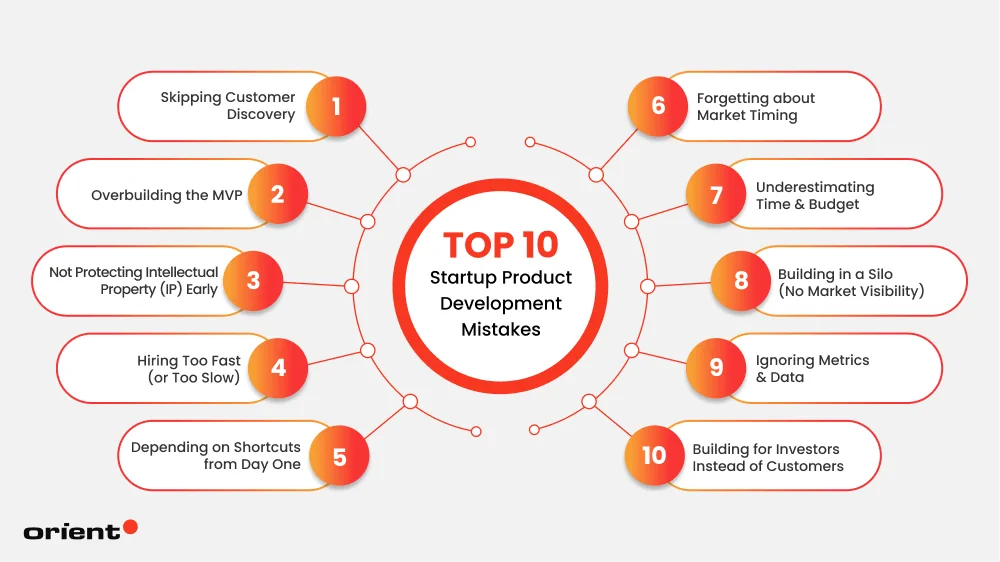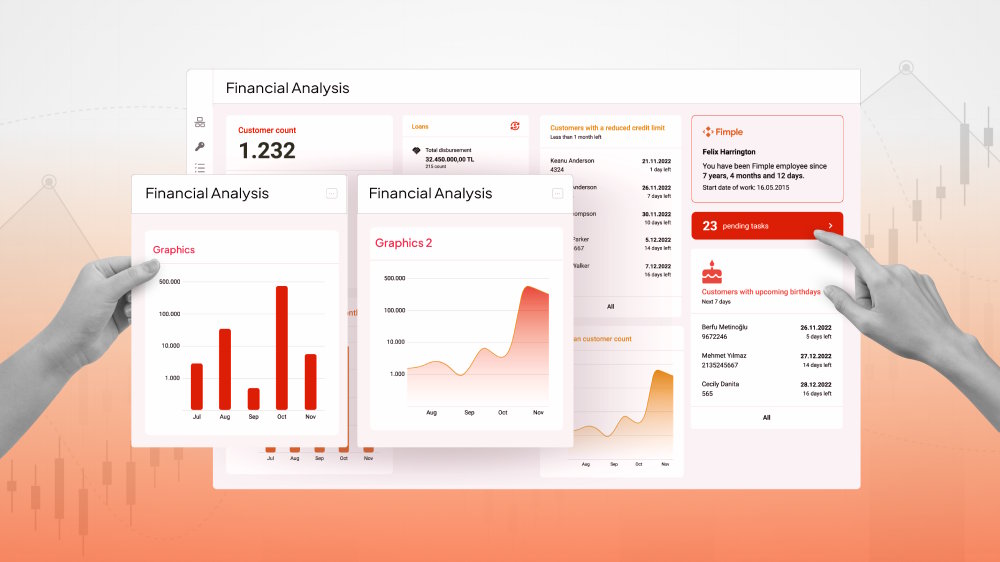Startups are emerging rapidly these days, driven by a strong sense of ambition. However, not many companies can survive in the fiercely competitive market. While the lack of funding has always been a perennial problem, it is no longer the only reason why startups fail.
Did you know that nearly 90% of failures of young businesses stem from product development gone wrong? From overbuilding fancy features no one asked for to ignoring user feedback, even the most brilliant business ideas can collapse under the weight of poor execution.
The good news is that you are no longer alone in this path as “veterans” openly share their experiences based on their own past lessons. Serving as a survival guide, this article reveals the biggest pitfalls in startup product development that could sink your business, and of course, how you can overcome them and succeed.

Mistake #1 - Skipping Customer Discovery
Every startup starts with big ambitions and ideas. However, sometimes, some founders’ over-enthusiasm about their business ideas makes them mistakenly believe that users will definitely receive their ideas positively. The truth is, you can’t please everyone. Some users may love your conception, some don’t. What matters most is the opinion of the majority, your target audience. If you only do what you want and forget about the real needs of your customers, you risk building something nobody actually needs.
In doing business, customer needs are the top priority. That’s why in all product development processes, market research is always put first, acting as a guiding compass for every subsequent step. You may think such a task is time-consuming, but it is a worthwhile trade-off. You can learn more about your target market in many different ways, such as interviewing potential users, running surveys, and testing prototypes before coding.
In general, a typical customer discovery (user research) looks like this:
- Step 1: Define your assumptions about customers, their pain points, and your solutions.
- Step 2: Build an initial customer persona of your target audience.
- Step 3: Conduct customer interviews and ask about their problems.
- Step 4: Validate with data by running surveys, landing pages, or small ad tests.
- Step 5: Spot patterns that are frequent and painful.
- Step 6: Create simple prototypes to gather customer reactions.
- Step 7: Summarize your collected data in a report and repeat the discovery if needed.
Mistake #2 - Overbuilding the MVP
The Minimum Viable Product (MVP) is supposed to be a basic version of your future product, which only includes must-have features to solve one core problem and collect early adopters’ feedback. However, many startups (deliberately) forget this and try to impress customers by adding as many features as possible to their MVPs.
The results? The MVP development process drags on for months, draining resources before the startup even validates demand. “The product is not ready yet” sounds easy, but it leads to delaying a launch, which can result in losing perfect market timing to compete for market share and creating opportunities for competitors to overtake.
Instead of trying to cram features into the early stages of the project and aim for perfection, start small and focus only on the “Minimum Lovable Product (MLP).” In particular, prioritize features and implement them one by one according to the original direction. Iterative release cycles will help your application improve step by step while ensuring quality and maintaining a competitive advantage.
Mistake #3 - Not Protecting Intellectual Property (IP) Early
Rapid growth in product development has made good business ideas increasingly rare. Many founders believe their small size makes them invisible to competitors. However, if your brand shows promise, competitors, or even large companies, can replicate it quickly and often faster than you can scale. In fact, in 2004, Facebook (now Meta) faced a lawsuit from Harvard peers who claimed the social media idea was theirs. While Facebook prevailed, the event once again emphasized the importance of protecting Intellectual Property (IP).
You don’t want to change your brand name/logo/idea halfway through, do you? Protecting IP is not only important, but it should also be done early in the project. It is suggested that you leave your creative rights everywhere relevant, right from the concept development stage. For example:
- Register your own trademark for brand name, slogan, and logo.
- File a provisional patent to secure priority when you have a novel invention or technology.
- Cover creative work (code, designs, content) with copyrights.
- Sign NDAs with co-founders and employees to define ownership of work.
- Keep dated records of product development, designs, and ideas.
Mistake #4 - Hiring Too Fast (or Too Slow)
Some founders feel pressured or overexcited when getting early traction or funding, leading them to panic-hire a scaled product development team as soon as possible. In contrast, others worry about budget constraints, causing them to delay hiring and opt for employees who can wear multiple hats instead. The consequences? Hiring too fast drains resources and brings in employees without role fit, while under-hiring hinders growth and leads to software engineer burnout. Too much of a good thing is harmful. Instead of hiring just to fill empty seats, build the right team at the right time.
Our advice is to hire according to the needs and scale of the project at a given time and slowly scale up and down flexibly as the company grows. You can collaborate with all-rounded staff in the early stages of the project. However, once your product development strategy is more tangible and you know exactly what you need to do next, start hiring experts to scale functions (e.g., dedicated QA, data engineers, growth marketers). Freelancers or contractors also serve as a good solution if you want to test needs before committing to full-time hires.
Mistake #5 - Depending on Shortcuts from Day One
In the early rush to get a product out, startups often rely on quick hacks, duct-taped code, or fragile infrastructure just to “make things happen fast.” This approach is completely normal and is often done for a demo or proof of concept. However, it can become a double-edged sword if startup founders rely on shortcuts for too long without upgrading. As your product development efforts gain traction, you will realize more clearly than ever the weight of the real users.
As data collection increases along with the number of users, there will come a point where your product system, built based on shortcuts, can no longer handle it. Downtime occurs, causing you to lose credibility and user trust. As a business owner, you obviously do not want to start the new product development process again. To avoid encountering the situations mentioned above, aim to balance speed with scalability from the very beginning by:
- Using hacks that are “safe for now” (like using a no-code tool for a prototype) instead of ones that cripple growth later (like insecure authentication or unscalable databases).
- Keeping components loosely coupled so you can upgrade parts as you grow.
- Using cloud platforms like AWS, GCP, or Azure to automate scaling.
- Starting small instead of trying to build enterprise-grade systems at launch.
Mistake #6 - Forgetting about Market Timing
Zoom wasn’t the first video meeting tool, but when the COVID-19 pandemic hit, Zoom’s simplicity and reliability made it the right product at the right time. This example displays the importance of perfect timing in a successful product launch. Forgetting about market timing is one of the most subtle but deadly traps in the startup product development process.
Founders sometimes focus too much on the steps of idea generation, thorough market research, and customer acquisition strategies, and forget about the when. No matter how outstanding your product is, it can still fail if it enters the market too early (before users are ready) or too late (when competitors already dominate). Additionally, market trends such as technology breakthroughs, economic downturns, or regulatory shifts can all make or break adoption.
The solutions? Here we provide you with five easy ways to get the right market timing:
- Trendspotting: Track every shift (e.g., technological shifts, economic shifts) that could block or enable product adoption.
- Customer Readiness: Evaluate the urgency of using a product.
- Competitive Landscape: Enter before the market is saturated, but after awareness exists.
- Beta Testing: Use soft launches or MVPs to gauge readiness before scaling.
- Flexibility: If timing seems off, pivot to adjacent markets or features while waiting for adoption.
Mistake #7 - Underestimating Time & Budget
As people who have never run a business, startup teams are often overly optimistic about how little their product costs and how quickly they can launch software. As a result, they tend to set tight timelines and lean budgets to impress investors even without careful calculations. However, in reality, time and budget are some of the most unpredictable factors in a startup product development journey, and reality rarely goes according to plan, leading to a series of consequences such as budget blowouts and turnover when goals cannot be met.
This is also a common mistake that even established companies with successful product development make. In fact, in 2012, Apple’s hasty release of its in-house Apple Maps app to replace Google Maps in iOS 6 without proper time and resource estimation led to widespread user complaints about inferior quality.
Building a product is not simply about app development. Rather, it covers a lot of things, from massive data infrastructure to the user trust that mapping products require. To avoid this mistake and start a product development lifecycle with confidence, consider these tips:
- Adding a contingency buffer for every estimation (e.g., 10-20% for cost, 30-50% longer for time) to cover the unpredictable future.
- Leveraging Agile methodologies and breaking the business plan into sprints instead of rigid long-term timelines.
- Tracking burn rate to know exactly how much you are spending monthly and how much runway is left.
Mistake #8 - Building in a Silo (No Market Visibility)
Research shows that startups engaging early adopters in user testing and MVPs are more likely to reach product-market fit. Yet many founders still fall into the trap of stealth development, a strategy in which companies, especially startups, develop software products in secret to keep information from competitors, create surprises for the market, and gain first-mover advantage at launch.
The problem here is that hiding your app until the official launch only cuts you off from customers - the individuals who bring real value and profit to your product. Without public visibility, there is no feedback loop and no audience waiting when your final product goes live. You will end up building a software product with the wrong features and usability issues. This explains why the days of stealth launches are fading as a result.
Today, to turn early visibility into a competitive advantage, modern companies tend to treat their audience as collaborators rather than just regular users and value every customer feedback. Many businesses even start building a user community on forums and Discord/Slack groups and publicize their roadmaps in the early stages of the project to attract potential customers and build trust while generating word-of-mouth buzz.
Mistake #9 - Ignoring Metrics & Data
Without data, everything is just guesswork and unfounded. However, because collecting and analyzing data is often complex and time-consuming, many early-stage teams prioritize intuition and speed over real measurement. Founders assume they understand their users’ needs, leading to the idea that tracking numbers is redundant. On the other hand, some startups do use data to evaluate product effectiveness, but simply rely on vanity metrics like total downloads or sign-ups. Those numbers look impressive on a pitch deck but reveal little about real traction.
So, what data really matters? To understand whether your product is truly solving customer problems, look into metrics such as activation rate, churn, retention, customer acquisition cost (CAC), and lifetime value (LTV). Using supported tools, starting with lightweight ones, including Google Analytics, Mixpanel, or Amplitude, will help you identify friction points and make decisions grounded in reality.
Mistake #10 - Building for Investors Instead of Customers
Instead of creating a business plan that fits the current needs of potential customers, founders sometimes, to impress investors, risk creating one optimized for pitch decks, not for people.
We don’t mean that impressing investors is wrong; as young startups, budget considerations are critical for the project’s survival. However, you should also know how to balance between investors’ expectations and users’ needs. After all, customer satisfaction is what nurtures a successful product development journey. If you only focus on impressing investors, your product may look irrelevant or confusing in the eyes of consumers. And obviously, no customer wants to engage with or use a product that does not bring much real value to their lives. In the long run, you will realize that no amount of investor enthusiasm can compensate for the absence of real customer love.
The antidote here is straightforward but requires discipline: always put the customer first. You should:
- Talk to your customer regularly.
- Measure your customer’s engagement.
- Iterate around your customer’s pain points.
Ready to Start Your Startup Product Development Process?

Startup product development is the make-or-break phase for startups. Many young startups succeed, while others only abandon their innovative ideas in product concept when they make too many mistakes during the implementation process. However, that is not the reason for one to stop dreaming big. Every failure is a lesson to help startups mature in subsequent projects. Remember, success doesn’t usually come from the biggest funding round or the flashiest idea. It comes from a cycle of:
- Listening to customers
- Catching market timing
- Iterating quickly
- Managing resources wisely
- Staying flexible enough to pivot when needed
While many founders wish to build and manage everything in-house, the reality is that early-stage startups often lack the resources and expertise needed to go from idea to market. This is where partnering with a software development company like Orient Software becomes a game-changer. With 20 years of experience in the technology field, we understand what works and what doesn’t, helping your project grow fast without compromising quality. MVPs can be successfully built in weeks, quickly reaching target customers and creating a competitive advantage. To learn more about our pricing models, feel free to contact us and discuss your requirements.










